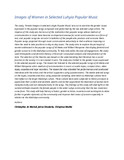Images of Women in Selected Luhyia Popular Music
Date
2022-11-14Author
Wechuli, Christopher, M.
Omuteche, Jairus
Wasike, Chrispinus
Metadata
Show full item recordAbstract
The study, ‘Female Images in selected Luhyia Popular Music’ sets out to examine the gender issues expressed in the popular songs composed and performed by the two selected Luhya artists. The impetus of this study was borne out of the realization that popular songs whose medium of communication is music have become an important avenue for social communication as a form of text, and popular songs do not exist in isolation of the people who produce and consume them. Popular songs projected through music communicate seductively to their audience imposing on them the need to take positions on day-to-day issues. The study aims to explore the portrayal of women addressed in the popular songs of Ali Akeko and Wilbert Wanyama that display feminist and gender concerns in the Abaluhya community. To help rationalize the area of engagement, the study used Ethnopoetics and feminist literary criticism for conceptual analysis and interpretation of the texts. The selection of the theories was based on the understanding that literature has a social function in the society; it is not created in vain. The study was limited to the gender issues expressed in the selected popular songs. The researcher listened to the selected popular songs of Ali Akeko and Wilbert Wanyama who’s medium of communication is music on audio tapes, compact discs, video tapes, cassettes and tape recorders. The researcher also attended live performances and conducted interviews with the artists and the artists’ supporters using questionnaires. The twelve selected songs on the tapes, cassettes and discs using purposive sampling, were taken as Abaluhya cultural texts that reflect on the larger Abaluhya culture. These cultural texts were subjected to literary analysis to appreciate their content and aesthetic wealth, and further apprehend the treatment of women both metaphorically and non-metaphorically in the songs. The findings of this study will shed light on the societal attitudes towards the female people in the wider Luhya community that the two musicians come from. This study will help literary scholars, gender activists, musicians and sociologists to delve further in gender dynamics of the community and improve their areas of concern especially in relation to the Ab/aluhya community.
URI
https://doi.org/10.2022/ajest.v7i2.821http://ajest.info/index.php/ajest/article/view/821
http://ir-library.mmust.ac.ke:8080/xmlui/handle/123456789/2148
Collections
- Journal Articles [411]

